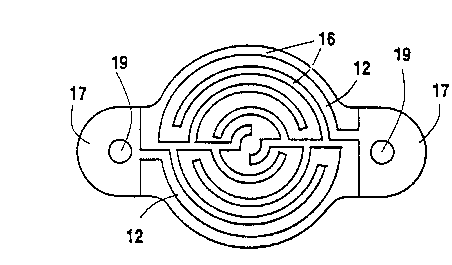Some of the information on this Web page has been provided by external sources. The Government of Canada is not responsible for the accuracy, reliability or currency of the information supplied by external sources. Users wishing to rely upon this information should consult directly with the source of the information. Content provided by external sources is not subject to official languages, privacy and accessibility requirements.
Any discrepancies in the text and image of the Claims and Abstract are due to differing posting times. Text of the Claims and Abstract are posted:
| (12) Patent: | (11) CA 2141340 |
|---|---|
| (54) English Title: | PYROLYTIC BORON NITRIDE HEATING UNIT |
| (54) French Title: | UNITE DE CHAUFFAGE DE NITRURE DE BORE PAR PYROLYSE |
| Status: | Expired and beyond the Period of Reversal |
| (51) International Patent Classification (IPC): |
|
|---|---|
| (72) Inventors : |
|
| (73) Owners : |
|
| (71) Applicants : |
|
| (74) Agent: | SMART & BIGGAR LP |
| (74) Associate agent: | |
| (45) Issued: | 1999-01-12 |
| (86) PCT Filing Date: | 1993-09-24 |
| (87) Open to Public Inspection: | 1994-04-14 |
| Examination requested: | 1995-09-27 |
| Availability of licence: | N/A |
| Dedicated to the Public: | N/A |
| (25) Language of filing: | English |
| Patent Cooperation Treaty (PCT): | Yes |
|---|---|
| (86) PCT Filing Number: | PCT/US1993/009053 |
| (87) International Publication Number: | WO 1994008436 |
| (85) National Entry: | 1995-01-27 |
| (30) Application Priority Data: | ||||||
|---|---|---|---|---|---|---|
|
The present invention relates to a pyrolytic boron nitride heating unit composed of a dielectric base of boron nitride and a
pyrolytic graphite heating element having contact ends for connection to an external power supply through a contact assembly
comprising graphite posts connected to the contact ends with each post having a pyrolytic boron nitride coating and exposed
attachment ends spaced a predetermined minimum distance from the contact ends for connection to the power supply. The contact
assembly preferably also includes flexible graphite washers for connection between the contact ends and the graphite posts.
La présente invention consiste en une unité chauffante qui emploie de la nitrure de bore pyrolytique, et un élément de chauffe pyrolytique en graphite muni de bouts de contact destinés à être connectés à une source d'alimentation électrique par un assemblage de contact comprenant des bornes de graphite connectées aux bouts de contact et où chaque borne comporte un revêtement de nitrure de bore pyrolytique et des extrémités de connections exposées espacées à une distance minimale prédéterminée des bouts de contact, pour connection à la source d'alimentation. L'assemblage de contact comprendra idéalement des rondelles flexibles en graphite pour connection entre les bouts de contact et les bornes en graphite.
Note: Claims are shown in the official language in which they were submitted.
Note: Descriptions are shown in the official language in which they were submitted.

2024-08-01:As part of the Next Generation Patents (NGP) transition, the Canadian Patents Database (CPD) now contains a more detailed Event History, which replicates the Event Log of our new back-office solution.
Please note that "Inactive:" events refers to events no longer in use in our new back-office solution.
For a clearer understanding of the status of the application/patent presented on this page, the site Disclaimer , as well as the definitions for Patent , Event History , Maintenance Fee and Payment History should be consulted.
| Description | Date |
|---|---|
| Inactive: Agents merged | 2013-08-13 |
| Inactive: IPC from MCD | 2006-03-11 |
| Time Limit for Reversal Expired | 2004-09-24 |
| Letter Sent | 2003-09-24 |
| Inactive: Correspondence - Prosecution | 1999-02-24 |
| Grant by Issuance | 1999-01-12 |
| Pre-grant | 1998-09-22 |
| Inactive: Final fee received | 1998-09-22 |
| Notice of Allowance is Issued | 1998-05-04 |
| Notice of Allowance is Issued | 1998-05-04 |
| Letter Sent | 1998-05-04 |
| Inactive: Status info is complete as of Log entry date | 1998-04-27 |
| Inactive: Application prosecuted on TS as of Log entry date | 1998-04-27 |
| Inactive: Adhoc Request Documented | 1998-04-21 |
| Inactive: Approved for allowance (AFA) | 1998-03-31 |
| Inactive: Delete abandonment | 1998-02-19 |
| Inactive: Abandoned - No reply to s.30(2) Rules requisition | 1997-10-28 |
| Amendment Received - Voluntary Amendment | 1997-10-28 |
| Inactive: S.30(2) Rules - Examiner requisition | 1997-04-28 |
| All Requirements for Examination Determined Compliant | 1995-09-27 |
| Request for Examination Requirements Determined Compliant | 1995-09-27 |
| Application Published (Open to Public Inspection) | 1994-04-14 |
There is no abandonment history.
The last payment was received on 1998-09-16
Note : If the full payment has not been received on or before the date indicated, a further fee may be required which may be one of the following
Please refer to the CIPO Patent Fees web page to see all current fee amounts.
| Fee Type | Anniversary Year | Due Date | Paid Date |
|---|---|---|---|
| MF (application, 4th anniv.) - standard | 04 | 1997-09-24 | 1997-09-24 |
| MF (application, 5th anniv.) - standard | 05 | 1998-09-24 | 1998-09-16 |
| Final fee - standard | 1998-09-22 | ||
| MF (patent, 6th anniv.) - standard | 1999-09-24 | 1999-09-02 | |
| MF (patent, 7th anniv.) - standard | 2000-09-25 | 2000-09-05 | |
| MF (patent, 8th anniv.) - standard | 2001-09-24 | 2001-08-31 | |
| MF (patent, 9th anniv.) - standard | 2002-09-24 | 2002-09-03 |
Note: Records showing the ownership history in alphabetical order.
| Current Owners on Record |
|---|
| ADVANCED CERAMICS CORPORATION |
| Past Owners on Record |
|---|
| MICHAEL HENRY SR. GILBERT |
| TIMOTHY JAMES HEJL |